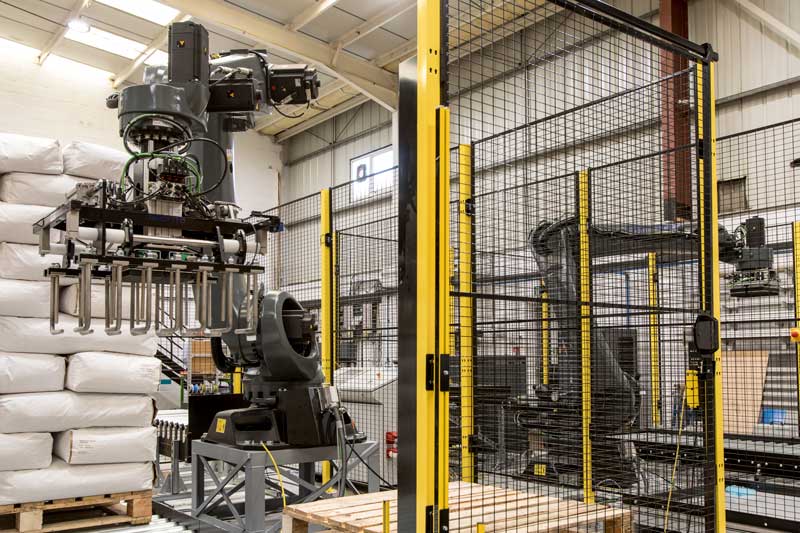
With the many advances there have been in the field of automation in recent years, there are now very few products that can’t be palletised automatically. However knowing which type of robotic palletiser is going to be best for your application can often be difficult to determine.
To ensure that the robotic palletising system will cover your current and future requirements, it is very important to ensure that the following key criteria is met:
- Can the system palletise as fast as, or faster than, the speed the production process can run at?
- Will the gripper head handle the product appropriately without damaging or dropping the product?
- If you are using slip sheets, can it place them?
- Is the system able to be quickly and easily reprogrammed for different product sizes by your staff?
Along with this criteria, one of the key elements of any robotic palletising system is the gripper as this is the part that is used to pick and place the product when palletising. Below we have explained in more detail as to the different gripper methods that can be used and which type of application they are most suited to.
Foam Vacuum Gripper
There are several different styles of vacuum gripper available, but the most commonly used one for palletising product is a flat foam head vacuum gripper.
A foam vacuum gripper is typically used where the top of the product is flat the item can be vacuum picked from the top. This would usually be items such as boxes, display boxes or cartons. However some types of vacuum packed products and bags can also be palletised using a vacuum gripper.
A vacuum gripper can also be used to pick and place pallets onto the conveyor, and to pick and place cardboard slip sheets.
Vacuum Row Gripper
Vacuum row gripping works on the same principle as a foam vacuum gripper but is able to pick and place multiple items at once. This increases the cycle speed and is a good choice for high speed production lines. A bump turn conveyor may be needed to orientate the product as it come off the production line.
A good vacuum row gripper palletising system will be able to palletise different types of product off more than one line. The row gripper can also be used to pick and place pallets onto the conveyor, and to pick and place cardboard slip sheets.
Bag Gripper
A bag gripper has positioning pins, lifting pins and a centre clamp which provides extra support as the product is moved.
Typically when a bag gripper is used, the robot will need to pick off a purpose manufactured sack pick conveyor to allow the pins to wrap round under the bag before lifting. The gripper closes the positioning pins and lifting pins around the product and clamps the centre clamp as it lifts the product off the conveyor. Once the robot has moved the bag to the correct position for stacking, the lifting pins release and the positioning pins guide the bag into place.
Due to the unique way in which the gripper works this results in a very neatly stacked pallet. The gripper also often has functionality included to pick and place the pallets onto the conveyor.
A bag gripper is usually only used for bags and sacks.
Underneath Gripper
An underneath gripper has tines that slides underneath the product, and an arm that goes across the top of the item and clamps down onto it to hold it in place. Once the product has been placed in the desired location on the pallet, the top clamp is released and the gripper tines are withdrawn from under the product. An underneath gripper also has an integrated vacuum gripper that is used to pick and place pallets onto the conveyor, and also to pick and place slip sheets.
Underneath grippers are used for a variety of different applications such as open top plastic or cardboard crates, open top boxes, boxes that are not strong enough to be lifted with a vacuum gripper, shrink wrapped items such as packs of bottles, etc.
Parallel Gripper
A parallel gripper has two side plates that close parallel to each other onto the two sides of the product and then lift it. This type of gripper is therefore most suited to boxes and is only used where the product is a regular shape, but vacuum gripping is not possible.
Bespoke Gripper
Sometimes a standard gripper will not lift product due to its size or shape in which case a bespoke gripper may need to be manufactured to meet your exact requirements. Products that would potentially require a bespoke gripper would include; drums, cans, bottles, irregular shaped items, etc.
A bespoke gripper would also typically be designed to be able to pick and place pallets and slip sheets as well.
One of the best ways to ensure that the robotic palletising system you choose is able to meet your requirement is to trial your product on the proposed solution. This will enable you to see if the system is indeed able to handle your product successfully and at the speeds required. In the case of sack palletising, you will also be able to see how neatly the finished pallet is stacked.
We currently offer a free, no obligation palletiser trial service. If you would like to take advantage of this, Click here to book, or contact us on 01223 499488.
If you would like to discuss your palletising application, then feel free to get in touch with us on 01223 499488 or helpline@granta-automation.co.uk and we will be very happy to help.








Warning: Undefined variable $aria_req in /var/www/granta-automation.co.uk/news/wp-content/themes/twentyten/comments.php on line 81
Warning: Undefined variable $aria_req in /var/www/granta-automation.co.uk/news/wp-content/themes/twentyten/comments.php on line 86